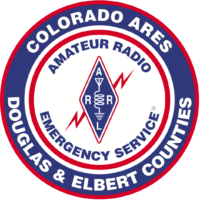
The standard 12 VDC power connector for the ARES/RACES group in ARESDEC is the Anderson Powerpole. Click here to read an article from West Mountain Radio about how to install Anderson Powerpoles. These connectors are inexpensive and can be easily obtained by ordering them from various vendors on the Internet. The connectors are genderless and easy to install. Various types exist to fit your power needs, with pins that can handle various amperage and wire gauges. The housing size remains the same, but the pins that get inserted into the housing will vary according to their amperage capability.
Common amperage and wire gauge options for the pin inserts include:
15 Amps, 16-20 gauge conductors
30 Amps, 12-14 gauge conductors
35 Amps, 12-14 gauge conductors
45 Amps, 10 gauge conductors
75 Amps, 8 gauge conductors
75 Amps , 6 gauge conductors
Be sure to use a wire gauge and appropriate Anderson Powerpole pin insert that can handle the required current draw of the attached equipment. And never remove strands from the end of a stranded wire to make it fit into a smaller pin.
The Powerpole housings can be sold as separate red and black housings where a roll pin should be inserted in a small hole that is created when the housings are slid together. The roll pin keeps the housings from separating during use. Optionally, housings are available that have been bonded at the factory and therefore do not need the roll pin.

Kits are available with housings and pins that are good to have at home and in the field. This allows for quickly getting a power cable assembled at an impromptu moment.

In order to properly crimp the Anderson Powerpole pin to the cable, a crimp tool is necessary. Do not use pliers or other tools to make the crimp, as they will not do a proper job of crimping the pin to the cable. You do not need to solder the pins to the cable, as a proper crimp tool will create a strong mechanical bond between the pin and the cable.

Various manufacturers make a variety of DC distribution blocks that take a 12 VDC feed via an Anderson Powerpole connection and distribute that feed to multiple Anderson Powerpole connections on the block. Some distribution blocks have individual fuses on each Powerpole connection to further protect your DC power source from short circuits or devices that might draw more current than the source can deliver. Some distribution blocks also have USB ports that output 5 VDC, which can be handy for charging a smartphone or other personal device. It is advantageous to have DC distribution blocks at home and in the field in order to effectively distribute a 12 VDC power source to multiple devices using Anderson Powerpoles.

The use of a common power connector for 12 VDC makes it much easier in the field when multiple individuals bring various power sources and various radios. If everyone uses the same power connectors on their radios and power sources, then the various devices may be interchanged with one another. It doesn’t do much good if one person has a battery that can’t be connected to someone else’s radio because the power connectors don’t match. Anderson Powerpole connectors for 12 VDC help create a common method of interconnecting power sources with radios and radio accessories.
